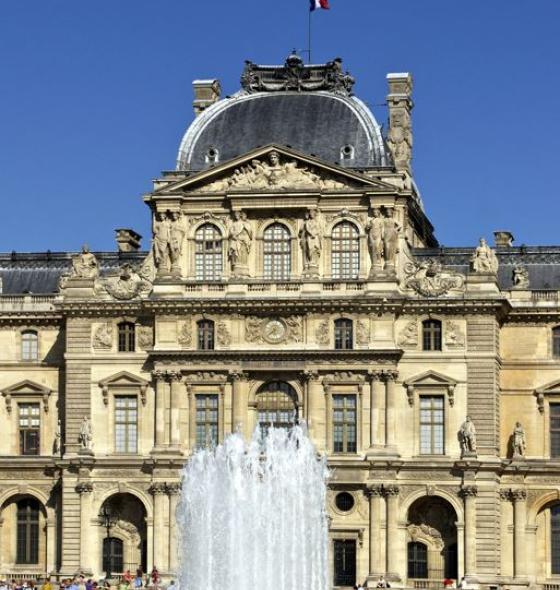
Expanding the Louvre : a history of museum growth (replay)
English summer session replay
Course number : CE13w
Thirty years after the “Grand Louvre” and the creation of Pei’s Pyramid, the “Nouvelle Renaissance” now carries this history forward, raising fundamental questions: does a museum remain vital by expanding, or does expansion ultimately challenge its very nature? Rereading the Louvre’s trajectory through a critical examination of museum growth offers a deeper understanding of how expansion has shaped, and continues to shape, its message.
Course objectives
Aimed at the widest possible audience, the Summer Courses offer a collection of thematic series on topics in archaeology, art history, social history and even anthropology, reflecting current events in museums, exhibitions and research. They take place throughout the summer in the form of thematic series of five 1h30 classes, taught by leading specialists, curators, academics, art historians, heritage professionals and researchers.
Course topic
The Louvre’s history is one of continuous expansion—architectural, institutional, and intellectual. Since its foundation in 1793, its growth has shaped not only its collections but also the museum’s role, function, and identity. Expansion has taken many forms. The inclusion of non-Western art and ethnographic objects in dedicated sections in the late 1820s, followed by the rise of colonial archaeology in the 1840s, reflected shifting values: the ambition to become an encyclopedic institution, a constantly evolving desire for classification, and a changing understanding of artistic and cultural narratives. Yet expansion has never been a seamless process. Growth has meant integration but also fragmentation, as collections once considered central to the Louvre were later transferred elsewhere. With expansion came tensions—between accumulation and coherence, inclusion and exclusion, centralization and dispersal. Expansion was also spatial. As the museum progressively occupied the palace, it reshaped the building and its very purpose. More recently, new forms of expansion—from the creation of the Department of Islamic Art and the Department of Byzantine and Eastern Christian Art to Louvre-Lens and Louvre Abu Dhabi—have continued to redefine its reach and significance. Thirty years after the “Grand Louvre” and the creation of Pei’s Pyramid, the “Nouvelle Renaissance” now carries this history forward, raising fundamental questions: does a museum remain vital by expanding, or does expansion ultimately challenge its very nature? Rereading the Louvre’s trajectory through a critical examination of museum growth offers a deeper understanding of how expansion has shaped, and continues to shape, its message.
Teaching methods
Replay summer courses are available on the École du Louvre's digital campus from July 14 to August 31, 2025.
Please note that registration for a Replay course does not give access to a classroom course and vice versa.
Classes will be held in English.
Course calendar
Barthélemy Glama Etchegoyen
Director of the Bonnat-Helleu Museum in Bayonne, Former Senior Advisor to the President-Director of the Louvre Museum
The sessions are available for replay on the School's digital campus from July 14 to August 31, 2025.
Session No. 1
A museum that grows, a museum that lives ? The Louvre’s perpetual metamorphosis
Session No. 2
Conquering the Palace: the spatial expansion of the Louvre
Session No. 3
The encyclopedic temptation: collecting the world
Session No. 4
Growth and fragmentation: the limits of universality
Session No. 4
Beyond the museum: expansion without walls
Rates
| Full rate | Reduced rate* |
| 110 € | 65 € |
| Decreasing full rate** | Decreasing Reduced rate** |
| 80 € | 50 € |
* The reduced rate is open to the following: young people under 26 years of age on December 31 following the date of the first session of the course in which they are enrolled, jobseekers, RSA recipients, AAH recipients.
**The degressive rate applies from registration for a 2nd summer course.
Course program
Auditor's card
Course access control
The École du Louvre auditor's card is used to control access to the courses in which you are enrolled and must be presented to gain access to the teaching areas.
Auditors of Paris courses and online courses
During its period of validity, your card entitles you to free, unlimited access to the permanent collections and temporary exhibitions of:
- musée du Louvre,
- musée Eugène Delacroix,
- musée d’Orsay,
- musée de l’Orangerie.
It offers reduced admission to :
- musée national des arts asiatiques - Guimet,
- musée Rodin,
- musée national d’art moderne (Centre Pompidou).
Please note: the École du Louvre auditeur libre card does not grant priority “coupe-file” access.
Contact
Postal address :
Service des auditeurs
École du Louvre
Palais du Louvre, Porte Jaujard
Place du Carrousel
75038 Paris Cedex 01
FRANCE
Phone :
+33 1 55 35 19 23
e-mail :
